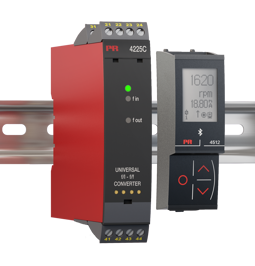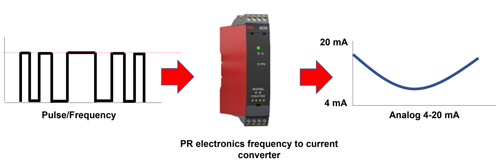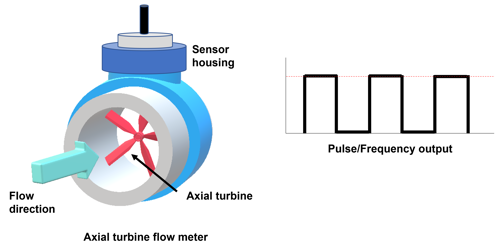What are frequency to current converters and what are they used for?
Frequency to current converters are used in control systems to transform a pulse or frequency to an equivalent current signal.
|
Speed and flow are two commonly measured process values. The safety and efficient product delivery of certain process applications relies on accurate speed and flow measurement.
Measuring speedTake rotating machinery such as compressors and turbines. Control of rotational speed is necessary to prevent an overspeed situation arising which could result in forces beyond equipment specifications. This could result in catastrophic equipment failure and or danger to personnel. |
 |
Speed monitoring and control is an important factor in other applications including wind turbines, material handling, HVAC, pumps, mixers, motors and many more. Speed control is a vital element in energy efficiency, productivity, equipment reliability and safety.
Speed signals often take the form of a frequency or pulse output. Typically, these signals would come from proximity sensors, rotary/linear encoders or tachos.

Often the frequency or pulse output from these sensors is converted to a representative current (mA) by a frequency to current converter, or voltage (V) signal by a frequency to voltage converter. This ensures universal compatibility with control inputs to a PLC, Variable Frequency Drive, local indicator or telemetry system for example.

Frequency to current or frequency to voltage converters such as the PR 3225 / PR 4225 is capable of supporting a selection of different pulse and frequency inputs including:
- NAMUR
- NPN / PNP
- Tacho
- S0 according to DIN 43864
- Switch contact
Measuring flow
Whether it be liquid, gas or steam; flow rate is measured and controlled across many industrial processes. Applications include influent, effluent and aeration within wastewater, gas feed for burners, steam control on boilers, natural gas distribution and many more areas where control of flow rate is critical to safety, load balancing and product delivery.
A number of techniques are available for flow measurement depending on the application including differential pressure, Coriolis, ultrasonic, vortex and turbine.

Many of these flowmeter types have a pulse/frequency output representative of the flow rate being measured. An example is the turbine flowmeter shown above which uses a magnetic pickup to measure rotational speed of the turbine as the blades pass the sensor, and outputs a relevant pulse/frequency signal proportional to the flow rate.
What is frequency to current conversion?
The pulse or frequency outputs from the various sensors and transmitters used to measure speed and flow, are often converted to a current or voltage signal for interfacing with a control system.
Frequency to current converters or frequency to mA converters convert the relevant speed or flow signal to a corresponding current signal, typically 4-20 mA. These devices often include galvanic isolation to help eliminate the signal noise and transients often associated with the heavy motors and rotating machinery applications. Additional device functionality is usually available in more advanced products to meet the interface requirements of more advanced applications.
PR electronics offers a range of frequency to current converters with options for relay or NPN/PNP outputs in addition to or concurrent with the analog outputs. Options are also available for pulse division and multiplication to meet the interfacing challenges of legacy and future applications.
What is frequency to voltage conversion?
Alternatively frequency to voltage conversion can also be used where the signal is converted to a corresponding voltage, typically 2-10 V depending on the interface requirements. The flexibility of PR electronics range of devices allows for either frequency to current or frequency to voltage conversion in the same device.
What is frequency to frequency conversion?
Some applications require a frequency signal to be modified to meet the demands of the downstream device. This can be due to gearing or response times, where frequency division or buffering may be required. A frequency output also allows for potential use as a frequency or time base generator.
Advantages of PR electronics f/l & f/f converters
As with all our products, PR electronics frequency signal conditioning products offer market leading technology, performance and flexibility. The extended frequency range, fast response time and high accuracy of PR electronics frequency to current converters make them an ideal choice in speed and flow monitoring applications.
Some of the features available include:
Technology
- High galvanic isolation – up to 3.75 kVAC
- NE 21 – Criterion A EMC performance
- 18-bit signal dynamics
Performance
- Fast response times - to < 30 ms
- Low power consumption
- Wide ambient operating temperatures
- High frequency capability – up to 100 kHz
Flexibility
- Universal power supply options
- 6 mm wide device options
- Panel mount display option
- Wide range of input types
- Selection of dedicated and concurrent output options
- MODBUS output option available
- 4500-series configuration options
- ATEX and SIL options
Please visit the product pages listed below for more information.
We can also offer a range of ancillary products for frequency applications including inductive proximity sensors.







